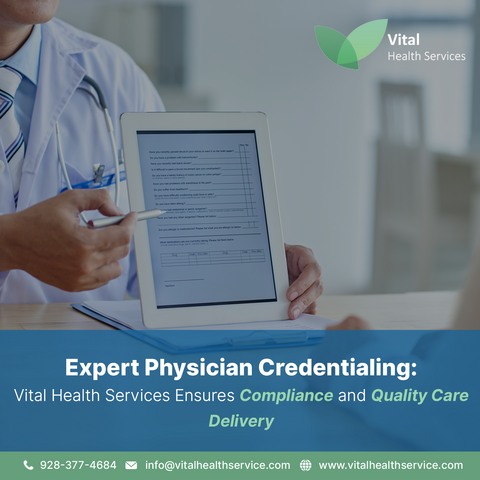How Much Does Physician Credentialing Cost in 2025 ?
Physician credentialing costs in 2025 vary, with typical out-of-pocket fees ranging from $100–$300 per provider for application-related expenses, and third-party services costing $2,500 to $5,000 for initial full service.
Costs depend on whether credentialing is handled in-house or outsourced, the number of insurance panels, state licensing requirements, and the complexity of the provider’s history, with ongoing upkeep for outsourced services costing $100–$250 per month.
Table of Contents
What Factors Influence the Cost of Physician Credentialing?
Several key factors can affect the overall cost of physician credentialing:
In-House vs. Outsourced:
Outsourcing is often more cost-effective for smaller practices with fewer providers, while larger organizations with dedicated administrative teams may benefit from handling credentialing in-house.Number of Insurance Panels:
The more insurance panels a provider needs to be credentialed with, the higher the total cost due to additional applications and enrollment fees.State Licensing:
Costs can vary widely by state, as some medical boards charge higher fees for license verification and credential checks.Provider History:
Providers with extensive work histories, malpractice records, or multiple state licenses often face higher costs because of the increased verification workload and documentation requirements.
What Is the Cost Breakdown for Third-Party Physician Credentialing Services?
Third-party credentialing services provide a convenient, “done-for-you” approach that streamlines enrollment and often results in faster approval times, though the initial investment is typically higher.
Here’s a breakdown of typical costs:
Initial Setup:
A one-time fee of approximately $2,500 to $5,000 per physician for initial enrollment with multiple insurance payers.Ongoing Support:
Continuous credentialing management and renewals may cost an additional $100 to $250 per month, depending on the level of service and the number of providers.Per-Payer Fees:
Some credentialing companies charge on a per-insurance-panel basis, typically ranging from $250 to $500 per payer.
What Is the Cost of In-House Physician Credentialing with Dedicated Staff?
In-house credentialing replaces third-party vendor fees with internal labor and software costs, making it a viable option for larger practices that have dedicated administrative teams.
Here’s a breakdown of typical costs:
Staff Time:
Each credentialing application can require 30 to 40 hours of administrative work, resulting in an estimated payroll cost of $750 to $1,000 or more per physician.Software:
Comprehensive credentialing management software typically costs between $1,200 and $4,800 per year, depending on features and the number of users.Total Internal Cost:
Combining staff labor and software expenses, in-house credentialing can total $2,000 to over $5,000 per physician annually.
What Is the Cost of Do-It-Yourself (DIY) Physician Credentialing?
The DIY approach is the cheapest in terms of direct expenses, but it’s generally suitable only for small practices with limited payer requirements and ample administrative time.
Typical cost breakdown:
Filing Fees and Background Checks:
Expect to spend around $1,000 to $2,000 on direct costs such as application filing, verification, and background checks.Hidden Costs:
Although inexpensive upfront, DIY credentialing can become the most costly in staff time due to errors, rework, and missed billing opportunities during processing delays.
What Additional Fees Apply to All Credentialing Methods?
Regardless of whether you choose outsourced, in-house, or DIY credentialing, several universal costs apply across all methods:
Licensing and Application Fees
DEA Registration Renewal: $888 every three years
State Medical License Verification: $25–$150 or more per state
Board Certification Verification: Up to $395 per provider
Hospital Privileging: $500–$1,000 per hospital for application and privileging
Group Enrollment: $300–$450 to set up a group practice account
Re-Credentialing: Typically $150–$250 per payer, required periodically and less expensive than initial enrollment
What Factors Significantly Impact the Cost of Physician Credentialing?
Several factors can greatly affect total credentialing expenses:
Number of Payers:
Each insurance panel (Medicare, Medicaid, commercial plans) requires a separate credentialing packet, increasing total costs.Practice Location:
States with complex regulations and multiple payers — such as California and New York — tend to have higher credentialing costs.Physician Specialty:
Specialists generally face higher costs due to more detailed training histories and participation in a larger number of insurance plans.Practice Size:
Larger healthcare systems can achieve economies of scale, reducing the cost per provider.Hidden Costs of Delays:
A credentialing delay can cause major revenue loss. For example, a 90-day delay may result in up to $108,000 in lost billable visits per physician.
What Is the Cost of Individual Physician Credentialing?
Individual physician credentialing typically ranges from $100 to $200 per physician, with recredentialing usually required every two years.
What Additional Fees Are Involved in the Credentialing Process?
Additional costs may include:
Application fees
Insurance panel enrollments: $100–$200 each
CAQH database setup: $200–$500
Ongoing management fees: $50–$100 per month
Breakdown of Physician Credentialing Costs
| Cost Factor | Price Range Per Physician | Notes |
|---|---|---|
| Individual Physician Credentialing | $100 to $200 | Usually required every 2 years |
| CAQH Database | $200 to $500 setup + $50 to $100 monthly | For online provider data collection and management |
| Insurance Panel Applications | $100 to $200 per application | Payments for joining insurance networks |
| Staff Time (In-house) | $750 to $1,000 (one-time) | Staff admin hours for credential management |
| Credentialing Software | $1,200 to $4,800 annually | Tools for tracking documents, alerts, and sync |
| Third-party Credentialing Service | $2,500 to $5,000 (one-time) + monthly support | Full-service credentialing and enrollment management |
How Much Does Full-Service Credentialing Outsourcing Cost?
Outsourcing credentialing to a professional service can cost between $3,000 and $8,500 in the first year, depending on the level of end-to-end management and maintenance provided.
What Factors Influence Physician Credentialing Costs?
Key factors affecting overall costs include:
The number of physicians in the practice
The growth rate of the organization
Changes in payers or providers
The level of automation or outsourcing used
Additional Considerations
Delays in credentialing can lead to significant lost revenue, around $100,000+ for a 90-day delay per physician.
Cost differences occur by state due to varying credentialing requirements, paperwork, and local policies.
Outsourcing can reduce administrative burden but may carry higher fees for comprehensive management.
Compare in-house vs outsourced credentialing costs
Here is a detailed comparison of in-house versus outsourced physician credentialing costs:
| Aspect | In-House Credentialing | Outsourced Credentialing |
|---|---|---|
| Annual Cost per Physician | Often exceeds $20,000 annually | Typically $2,000 to $3,000 per physician annually |
| Staff Costs | High—includes salaries, benefits, training; about $20,000 yearly at $100/hour for one physician | Minimal or none—outsourcing eliminates need for dedicated staff for credentialing |
| Software and Tools | Requires specialized credentialing software costing $1,200 to $4,800 annually | Software included as part of service |
| Verification Fees | Paid separately, including state boards and primary sources | Included in service fees or billed separately |
| Errors and Rework | Higher risk, leading to additional costs and delays | Lower error rates due to professional expertise |
| Time and Efficiency | Time-consuming; detracts from patient care and practice management | Faster turnaround and streamlined process |
| Compliance and Updates | Practice must keep current on regulatory changes | Credentialing services maintain up-to-date compliance |
| Setup Fees | N/A | Setup fees vary from a few hundred to a few thousand dollars |
| Flexibility and Control | Full control over credentialing process | Less control but less administrative burden |
How payer enrollment fees vary by insurer
Payer enrollment fees vary significantly by insurer and type of insurance program:
Medicare Enrollment Fees: For 2025, institutional providers pay an enrollment application fee of $730 for initial enrollment, revalidations, or adding new practice locations. Physicians and non-institutional providers typically do not pay this fee. Exceptions exist for hardship cases where fee waivers can be granted.
Medicaid Enrollment Fees: These vary widely by state, with some states charging fees similar to Medicare’s and others charging less or none. For example, Texas Medicaid’s fee increased from $709 to $730 for 2025. Providers pay this for initial enrollment, revalidation, or new location enrollment.
Private Commercial Insurers: Enrollment costs vary more and may include application fees ranging from $100 to $500 per insurer, depending on the insurer’s policies. Some payers charge application fees; others don’t but may have other administrative costs. These fees are generally independent of government program fees and are charged per insurer.
Additional Variables: Costs can also include time spent collecting and submitting documents, negotiating contracts, and payer-specific requirements that may require additional administrative work and costs. Enrollment timelines can range from 60 to 180 days depending on the payer.
What is CAQH ?
CAQH, which stands for the Council for Affordable Quality Healthcare, is an organization that works to streamline and improve the healthcare industry by creating a centralized online platform where healthcare providers can store and manage their professional credentialing information.
This allows health plans, hospitals, and other healthcare organizations to access a provider’s up-to-date data, simplifying the provider credentialing process and reducing administrative burdens and costs for both providers and payers.
What Are the Costs for Healthcare Providers Using CAQH?
While CAQH ProView itself is free, providers may face indirect or third-party costs related to the credentialing process.
Common costs include:
⏱️ Time Investment:
Setting up a CAQH profile can take up to two hours for the initial application. Providers must also complete quarterly re-attestations to keep profiles up to date.🧾 Credentialing Services:
Outsourcing CAQH setup or management to a specialized company usually costs $150–$500 as a one-time fee.🔍 Supporting Verification Costs:
Additional third-party verifications often required in the credentialing process include:State license verification
DEA registration
Board certification verification
Background checks
Is Creating a CAQH Profile Free for Healthcare Providers?
Yes. Creating a profile with the Council for Affordable Quality Healthcare (CAQH) is completely free for all healthcare providers. However, costs may arise if you hire a third-party service to manage your CAQH profile or if you are a healthcare organization that accesses the CAQH database.
What Are the Costs for Healthcare Organizations and Payers?
Insurance companies and other healthcare organizations that use CAQH must pay for database access.These membership fees fund the maintenance and development of CAQH’s solutions.
Exact pricing varies and is available directly from CAQH upon request.
How Can Providers Use CAQH for Free?
Healthcare providers can avoid third-party fees by managing their CAQH profile independently.
Steps to use CAQH for free:
Register: Create a CAQH ProView account on the official CAQH website.
Complete the Application: Fill out all required fields — personal details, education, training, and practice information.
Authorize Access: Grant specific health plans and organizations permission to view your data.
Attest Regularly: Every 120 days, review and attest that your information is current and accurate to keep your profile active.
Is CAQH credentialing mandatory?
When is CAQH essential?
- Joining insurance networks:Most commercial insurance carriers and state Medicaid programs require providers to have a CAQH profile to be considered for in-network status.
- Billing insurance:A centralized CAQH profile simplifies the process of getting credentialed with multiple payers.
- Working in larger settings:Many hospitals and group practices require providers to maintain a CAQH profile for their internal credentialing and network participation.
- Streamlining the process:Instead of filling out multiple applications for each insurer, CAQH allows you to enter your information once for many payers to access.
When might CAQH not be necessary?
- Strictly out-of-network or cash-based practices:If you only see out-of-network patients or operate as a cash-based practice (like some spas), CAQH may not be required.
- Specific provider types:Certain provider types not recognized by insurance companies may not need CAQH.
Why is it considered "practically mandatory"?
Without a CAQH profile, you will face significant hurdles getting credentialed with most payers, leading to delays or denials in joining networks. Insurance companies use CAQH’s ProView portal to access provider data and verify qualifications. Maintaining your profile by completing re-attestations every 120 days is also crucial to avoid interruptions in your credentialing and ensure continued network participation.
Is CAQH used in every state?
Who uses CAQH
- Most commercial insurers: Major commercial insurers like Aetna, Cigna, and UnitedHealthcare rely on a provider’s CAQH profile for the initial credentialing and re-credentialing process. Having a complete and up-to-date profile helps streamline the process of joining their networks.
- Many Medicaid plans: Many state Medicaid offices also use CAQH for credentialing, though specific requirements can vary by state and may involve additional steps.
- Providers in all 50 states: Healthcare professionals across all 50 states and Washington D.C. use CAQH to store and manage their information.
Who does not use CAQH
- Government payers: Medicare, Tricare, and other government-managed health plans do not use CAQH. Providers must credential directly with these payers.
- Some smaller health plans: Not all local and regional health plans use the CAQH database. In these cases, you may need to submit separate, manual credentialing paperwork.
The benefit of CAQH
What is the difference between NPI and CAQH?
NPI (National Provider Identifier): This is a unique 10-digit identification number assigned by the Centers for Medicare & Medicaid Services (CMS) to healthcare providers in the U.S. Its main purpose is to uniquely identify providers in administrative and financial transactions such as billing, claims processing, and regulatory compliance. The NPI is mandatory for all providers who bill insurance and helps standardize identification across healthcare entities.
CAQH (Council for Affordable Quality Healthcare) Number: This is a unique identifier assigned by the non-profit organization CAQH when providers register in the CAQH ProView system, which is a centralized online database for managing, storing, and sharing credentialing data. CAQH facilitates streamlined credentialing by allowing providers to enter their professional, educational, licensure, and malpractice information once and share it with multiple payers and health plans. The CAQH number is mainly used in the credentialing process and payer enrollment, reducing redundant paperwork and helping payers verify provider credentials efficiently.
Table: Difference Between NPI and CAQH
| Feature | NPI | CAQH |
|---|---|---|
| Issuer | CMS (Centers for Medicare & Medicaid Services) | CAQH (Council for Affordable Quality Healthcare) |
| Purpose | A unique identifier for all covered healthcare providers under HIPAA, used for health care claims, billing, and other transactions. | A non-profit organization that provides a centralized database (CAQH Provider Data Portal®) where providers self-report and share detailed professional and demographic information for credentialing. |
| Structure | 10-digit numeric identifier | Unique CAQH ID linked to the provider’s credentialing profile |
| Use | Required for all providers billing insurance | Used primarily for provider credentialing and payer enrollment |
| Data Included | Basic identification data | Detailed professional and credentialing information including licensure, certifications, malpractice, education |
| Role in Credentialing | Used as an identifier in credentialing processes | Main platform for submitting and updating credentialing details for payers |




